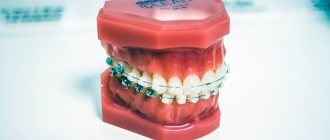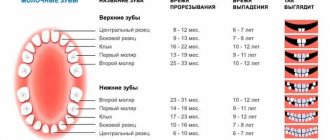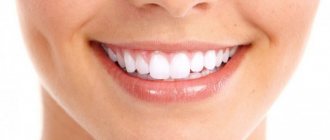The process of building and erupting baby teeth in children is quite painful and, as a rule, these features cause inconvenience not only to the baby, but also to his parents. Symptoms include redness and swelling of the gums, as well as crying and problems with appetite. Prepare for sleepless nights if you also notice short-term redness and a rash on your child's lower lip and chin. Unfortunately, a more severe process is also possible, accompanied by an increase in temperature. How are baby teeth structured, how long does it take for them to appear, and what should parents do during this difficult time? We will discuss this in this article.
Names of baby teeth
Temporary (baby) teeth are:
- incisors – eight front ones, located in the central part of the upper and lower jaw;
- canines, four symmetrically located, following the incisors;
- large molars or molars, two on each side of the upper and lower jaw.
Permanent teeth are:
- incisors – eight front ones, located in the central part of the upper and lower jaw;
- canines, four symmetrically located, following the incisors;
- small molars or premolars, follow the canines, 2 on each side
- large molars or molars. There are 8 of them (third molars or wisdom teeth do not always erupt)
Why is tooth numbering necessary?
All human teeth have their own specific location according to numbers. But how can you understand whether it is located on the upper or lower jaw, or on the left or right? You can use full formulations (for example, the first permanent molar of the upper jaw on the right). But such cumbersome names create certain difficulties for dentists and can often cause mistakes, which are especially dangerous if the patient is undergoing extraction of a diseased tooth.
In order to optimize the work of doctors and simplify the designation of tooth numbers as much as possible, special numberings were invented.
Baby tooth fell out
Every baby goes through the natural process of losing baby teeth. For some children this process is undesirable and painful, others, on the contrary, are happy about it, since now they are becoming adults.
Hair loss begins around the age of five, but this time is quite arbitrary, since much depends on the individual characteristics of the baby. The cause of loss is the growth and movement of permanent incisors, molars, and fangs, which put pressure on the milk teeth, causing them to wobble and then fall out.
Replacement occurs according to a natural pattern. Most often, the first molars (sixth) appear, and the lower central incisors change synchronously with it.
Teeth growing technology. Myths and reality.
For many years now, humanity has not only dreamed of immortality and technologies that would allow us to get rid of any diseases and eliminate various defects, but has also been working hard in this direction. Rapidly developing bioengineering promises us a lot of surprising and interesting things, including the hope that instead of damaged, destroyed and lost teeth, it will be possible to grow new, absolutely complete molars and not resort to installing artificial root implants and dentures.
Scientists have already discovered the gene responsible for tooth growth and enamel formation, and have also conducted a number of fairly successful studies on growing teeth in laboratory conditions for mice and rats. However, to this day there are no reliable facts confirming the possibility of transferring these technologies to humans and the readiness of such methods for widespread implementation in world dentistry.
Japanese scientists have officially announced the successful results of an experiment in which they grew a new tooth from mouse mesenchymal and epithelial cells (cells that are slightly higher than stem cells, i.e., more differentiated). To do this, the cellular material was placed in a special collagen frame and special technologies for growing new tissues were used.
Scientists actually managed to grow a new tooth consisting of dentin, pulp, enamel and having blood vessels and periodontal tissue. This tooth, measuring only 1.3 mm, or rather a tooth germ, was planted in an eight-week-old mouse into the socket of an incisor that had just been removed under anesthesia. An examination performed after two weeks showed that the new tooth had taken root well and began to grow and function in the same way as ordinary, natural mouse teeth, no different from them either in strength, structure, or appearance.
Thus, experts completely replaced the animal’s tooth with bioengineered materials. To make the observation of a growing tooth more accurate and clear, scientists added a green fluorescent protein gene to the cells. Thanks to this, it was possible to see exactly how cell division occurred and judge how correct this process was.
Experts say that the work done is an excellent basis for further research in this direction. In the future, it is planned not only to grow new teeth for humans in laboratory conditions (“in vitro”), but to use at least two methods for this:
- external - the new tooth is completely grown outside the body and then implanted into the patient;
- internal - a new tooth grows directly in the patient’s oral cavity from cells planted and pre-treated in the laboratory.
Today, specialists dealing with the problem of growing new teeth using bioengineering technologies face several challenges. First of all, scientists need to:
- improve the process of cell division in such a way as to ultimately achieve the formation of teeth with a natural ratio of enamel, dentin and pulp;
- to ensure that the new tooth will have the required size and shape, i.e. that a chewing tooth will not grow in place of the incisor and vice versa;
- achieve a high percentage of engraftment of the planted bioengineered material.
Anatomical structure of teeth
How does a human tooth work?
Considering the tooth as a separate organ, we can distinguish the crown, roots and neck. The crown is located in the oral cavity after complete eruption at the time of formation of the permanent bite. The roots of the tooth are located in the bone tissue in a special hole called the alveolus. The number of roots of a tooth, depending on its tasks, is normally from one to three. Wisdom teeth can have 4 or more roots. Between the crown and the root there is the neck of the tooth, which is the boundary between the above and below the gingival parts of the tooth.
The crown surfaces have the following names:
- Chewing (occlusal) is involved in crushing food and forming a bite
- Contact (approximal) are facing the adjacent teeth, front or back, ensure continuity (integrity) of the dental arch, participate in the redistribution of chewing loads along the entire dentition
- Buccal (external) and lingual (internal). These surfaces form the equator of the tooth to protect the surrounding gum neck from injury from pieces of food during grinding of hard food.
Request a call back or dial our number!
+7
This phone call does not obligate you to anything. Just give us a chance and we will help you!
Just pick up the phone and call us!
+7
We will definitely make you an offer that you cannot refuse!
Alternative names for human teeth
In addition to the official names, there are also alternative names for human teeth. They are not written in dental records, but have long been used in informal communication, since these teeth in people are located or grow in certain places or at certain times.
Eye teeth
The upper canines are called eye teeth because of their close location to the branches of the facial nerve. When they become inflamed, the pain radiates to the eye area and upper face. How close the incisive canals and the dental nerve are located to each other is shown in the figure:
Wisdom tooth
The wisdom tooth is the posterior third molar. He was called “wise” because he grows up in adulthood - when a person has already gained wisdom (by about 20 years).
Histological structure of teeth
All the most interesting things about human teeth can be learned using histology. Histology is a science that studies the morphological structure of organs and systems at the tissue level. Human teeth and roots consist of hard (97%) and soft (3%) tissues. Hard tissues are represented by dentin and enamel, and soft tissues are represented by vessels and nerves of the pulp, located in the so-called pulp chamber and root canals, inside the coronal and root parts of the tooth. The basis of the tooth is dentin.
The coronal part of the crown is covered with enamel on top of the dentin, and the root part, located in the bone, is covered with cement on top. The border where the root cement approaches the enamel of the coronal part is located in the area of the tooth neck. The roots of the tooth are attached to the bone tissue of the alveolar process of the jaw with the help of periodontal fibers, which is called the ligamentous apparatus of the tooth. With its help, the tooth can withstand chewing loads. The abundance of nerve fibers in the pulp is the cause of intense toothache with deep caries and pulpitis.
Tooth numbering schemes in dentistry
Currently, tooth numbers in dentistry are systematized according to several schemes:
- Universal numbering system.
- Square-digital or Zsigmondy-Palmer system.
- Haderup system.
- American numbering or alphanumeric system.
- European numbering Viola or WHO system.
Let's take a closer look at the features of each of them.
Universal system
This numbering scheme is based on assigning each permanent tooth a specific number from 1 to 32. In primary occlusion, each tooth has its own letter. In this case, the count is carried out from the right half of the upper jaw clockwise from the wisdom tooth.
The dental formula of a permanent set according to the universal system looks like this:
Milk teeth are marked according to the same principle, but only using letters of the Latin alphabet:
Zsigmondy-Palmer system
This numbering is the most imperfect, since it still indicates the teeth under numbers without a more precise indication of their location. At the same time, Arabic numerals from 1 to 8 are used for the permanent set, and Roman numerals (IV) are used for numbering dairy products.
The digital system does not exclude errors when carrying out diagnostic or therapeutic measures, therefore, today it is used only by orthodontists (for example, when installing and marking braces) or maxillofacial surgeons. And entries on it in the patient’s medical record are made only on a special diagram.
Haderup system
Numbering according to the Haderup system also applies to digital numbers. To designate the teeth of an adult, Arabic numbers 1-8 are used with a plus or minus sign in front of them. The “+” sign is used to number the upper ones, and the “-” sign to indicate the lower ones.
The numbers of children's teeth are similarly written in Arabic numerals with the signs “+” or “-”, but at the same time the number “0” is placed in front of them.
The inconvenience of such a system is the need to indicate the location of the tooth on the left or right side of the jaw.
American alphanumeric system
This numbering is widespread in the USA. The alphanumeric system is based on assigning a letter value to each group of teeth (capitals for a permanent set, and capitals for a primary set), as well as a digital code that indicates the location of the tooth in a correct bite.
Letter meanings of teeth:
- I (i) - permanent (deciduous) incisors;
- C (s) - permanent (deciduous) fangs;
- P - premolars (absent in primary dentition);
- M (m) - permanent (deciduous) molars.
American numbering also does not take into account the left- or right-sided position of the tooth, which can cause certain difficulties.
European international numbering Viola
Today, this is the newest and most advanced teeth numbering system. Its essence lies in the fact that the jaws are divided into segments (2 on top and 2 below), each of which is assigned its own number. For adults, numeric values are used 1-4, and for children - 5-8. As a result, each tooth receives a two-digit number, the first digit of which indicates a specific segment, and the second - a serial number.
The convenience of the Viola system lies in the absence of cumbersome names while accurately indicating the location of the required tooth and the minimal risk of error. This numbering is indispensable when sending a patient for an x-ray, as well as when identifying teeth on a panoramic image.
How to determine the tooth number - practice with examples
Determining which teeth numbers are quite simple, you just need to practice a little with examples.
Tooth number 37 - which one is it?
To an unknowing person who is not familiar with the numbering systems in dentistry, it may seem that we are talking about an extra 5 teeth in the mouth. But that's not true. According to the Viola system, teeth with numbers starting with three are located on the lower jaw on the left. And serial number 7 corresponds to the second molar. This means the 37th tooth is the second lower molar on the left.
What number corresponds to the upper right wisdom tooth (eight)?
The third molar will be designated differently in different systems.
- In the universal number scheme - number 1.
- According to the Zsigmondy-Palmer scheme - “upper right eight”.
- According to the Haderup system - “+8 on the right”.
- In the American scheme - “upper M3 on the right”.
- According to the Viola system - number 18.
For a school-age child, the dental formula says that next to tooth 21 there is tooth 62. How can this be?
In children at 6-7 years old (less often at 8-9 years old), the replacement of milk teeth begins. Therefore, both teeth from a temporary set and already erupted permanent teeth can be located in the mouth at the same time. In this situation, they are numbered according to the Viola system, and their numbers indicate that the central upper incisor on the left (number 21) has already been replaced by a molar, but the lateral incisor is still from the primary bite (therefore it is marked under number 62).










